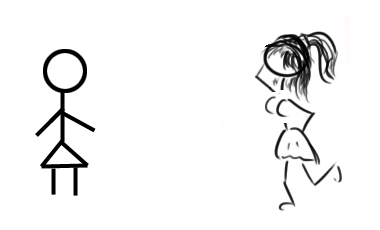New models sometimes raise the point that there aren’t that many ‘average’ models that show up in media, catalogs, and pin-ups. Are average people skipped over? Is the genetic bias a wider gap than it ought to be? And why do there seem to be so few casting calls to the average person waiting to be discovered?

The very question itself, “Why no average models?” raises an interesting conflict that marketing has been struggling with for a long time. Because an “average” person does, indeed, show how a given product would look on an average person, giving a truer representation.
However, the problem is that often doesn’t look very flattering — and people, in large sample groups, tend to go for superficial looks rather than actual reality. As such, marketing tends to go for those images which convey, whether true or not, that purchasing their product will raise your self esteem in the direction of the presented ideal. That’s often good enough. It doesn’t have to actually deliver perfection.
When it comes to looking at people for the sake of looking at people, which is more attractive: Brad Pitt or the average beer-gut guy you find the barbershop who thinks styled hair is pointless? The eye clearly has a higher level of attraction to one over the other. Biologically, we can even measure it, even if psychologically we pretend to hide it. Playing to that hard-wired response sells products.
So, this might explain why the “average” look hasn’t been splashed all over the media; everything is about optimizing profits, not representing reality.
Now this is something surprising that one might find very comforting. The people I’ve selected to show in my online profiles are actually are not models and have no prior modeling experience. I do this deliberately because what my studio focuses on is taking average people, revealing their extra hidden beauty, and capturing that — I want to be able to show my clients that they too, no matter how average looking they think they are, can look that good. And, if you’re going to make a bold claim like that, one better have the portfolio to back it up. If I just simply showed all my experienced model/actress shots, people think “well, yea, she’s a professional and I’m not that pretty” and I’ve lost a potential client. Customers rarely seem to be looking for how technically competent one’s photography skills are, but rather how good you can make them look.
Here’s where things get slightly obscured. If an “average” person is photographed to look like an above-average person, are they no longer considered average?
An employee at Kinko’s shared this astounding observation to me: numerous women customers bring in portfolios to have various images re-produced en masse. He’d look at the jaw-dropping photos and ask, “Who’s this?” only to be more surprised when the answer was “That’s me!” He reports the his customers almost always, without the added magic of the camera, were not hot but actually less attractive than the average woman. Sans makeup and pushup, quite a number of models are plain ordinary.
In fact, we know this to be true; browse any celebrity-stalker web site where someone has caught a celebrity when their publicist hasn’t been able to filter the image from public consumption. Such images range from unflattering to just someone you’d pass by in a crowd.
You have to compare your average self with their average self, or your modeling headshot to their modeling headshot. If you compare apples to oranges, it’s not just an unfair disadvantage, but an unrealistic one. Many people are far more attractive than they give themselves credit for. Does the makeup really make you that much prettier, or is it that your belief that it does actually turn on your self-confidence?
That said, I’ll point out that an experienced model is a joy to work with; it requires far less work on part of the photographer and one typically get a high quality product in far less shoot time.
I suspect it’s assumed that an experienced model (or her agent) will know where to go find placement casting calls, and thereby save the casting director a lot of time by skipping inexperienced labor. Running a photo shoot is very expensive, and if you can cut this time down, you save money.
This is different from casting calls which try to discover someone new; those usually happen in areas of high density to increase the odds, such as major cities.
